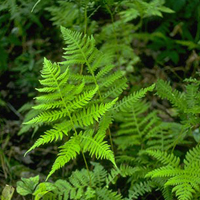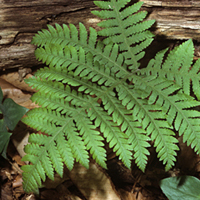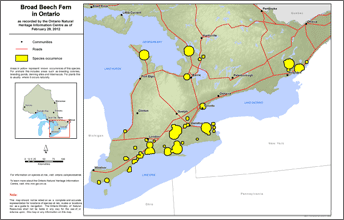Broad beech fern
Scientific name: Phegopteris hexagonoptera


Cover photos credit: : Donald A. Sutherland
Status
Special Concern
“Special Concern” means the species lives in the wild in Ontario, is not endangered or threatened, but may become threatened or endangered due to a combination of biological characteristics and identified threats.
Date added to the Species at Risk in Ontario List
The Broad Beech Fern was already assessed as a species of special concern when the Endangered Species Act took effect in 2008.
What it looks like
The Broad Beech Fern has fronds (large divided leaves) which can grow from approximately 25 to 75 centimetres long. The leaf blade is broadly triangular, 15 to 30 centimeters or more long and about as wide at the base, tapering to the top.
Where it lives
The Broad Beech Fern prefers to grow in rich soils in deciduous forests, often in areas dominated by maple and beech trees. It requires moist soil and usually grows in full shade.
Where it’s been found in Ontario
The Broad Beech Fern grows in eastern North America from the southern Great Lakes region west to southeast Kansas and northeast Oklahoma, south to northeast Texas and the Gulf Coast and east to the Atlantic coast. In Ontario, the species is found in forest remnants in southern Muskoka, along Lake Erie, and in the eastern Lake Ontario-St. Lawrence River region.
View a larger version of this map (PDF)
What threatens it
Ontario is the northern limit for this species. Historical records suggest that the species was once more widespread in Ontario with approximately 70 occurrences known, most of which are now deemed historical. It may have declined in Ontario as forests were cleared.
Action we are taking
Special concern species do not receive species or habitat protection.
Management plan
A management plan advises the ministry on ways to ensure healthy numbers of the species return to Ontario.
Read the management plan (June 28, 2013).
Government response statement
A government response statement outlines the actions the government intends to take or support to help recover the species.
Read the government response statement (March 7, 2014).
What you can do
Report a sighting
- Report a sighting of an endangered animal or plant to the Natural Heritage Information Centre. Photographs with specific locations or mapping coordinates are always helpful.
Volunteer
- Volunteer with your local nature club or provincial park to participate in surveys or stewardship work focused on species at risk.
Be a good steward
- Private land owners have a very important role to play in species recovery. You may be eligible for stewardship programs that support the protection and recovery of species at risk and their habitats.
- The Carolinian forests of southern Ontario support an amazing diversity of plants and wildlife, including many species at risk. Carolinian Canada is working to help recover species at risk and their habitats. For more information, visit: www.carolinian.org/SpeciesHabitats.htm.
Report illegal activity
- Report any illegal activity related to plants and wildlife to 1-877-TIPS-MNR (847-7667).
Quick facts
- Broad Beech Fern reproduces through spores. The spores are contained in a case-like structure called a sporangium. The sporangia burst upon maturity at the end of summer and the spores are scattered through the air.
- The stem of the Broad Beech Fern is described as creeping, scaly and somewhat pulpy.
- The Broad Beech Fern is a member of the "marsh fern" family, Thelypteridaceae.
